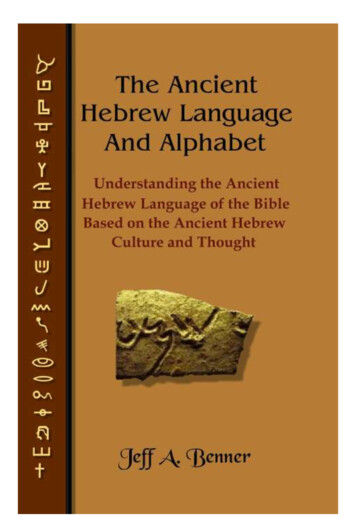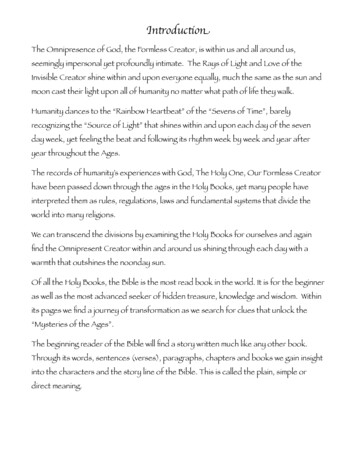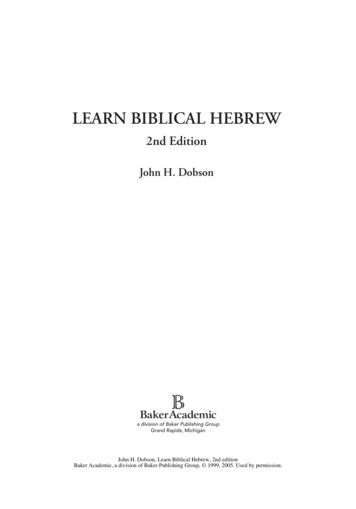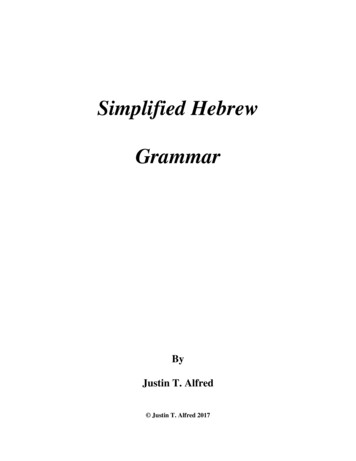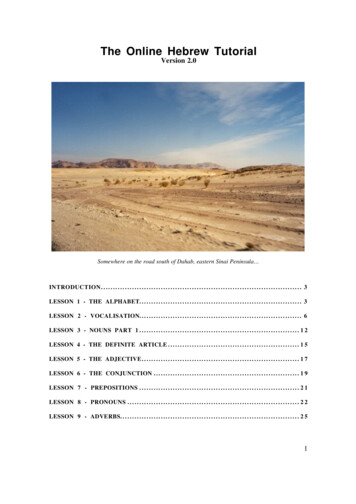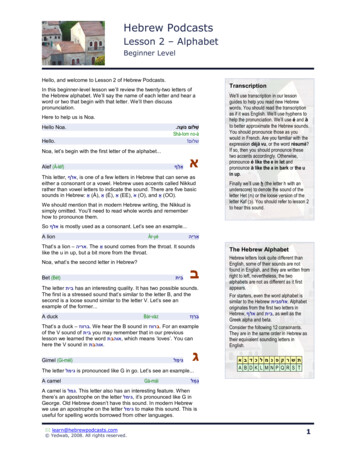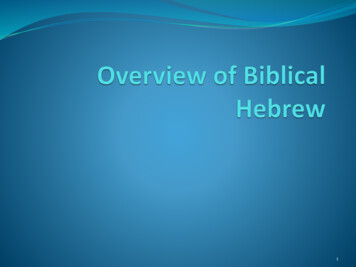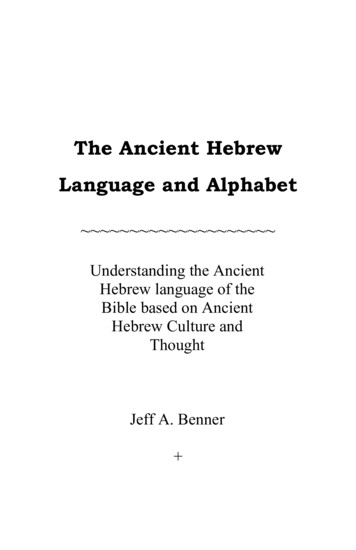
Transcription
The Ancient HebrewLanguage and Alphabet Understanding the AncientHebrew language of theBible based on AncientHebrew Culture andThoughtJeff A. Benner
The Ancient Hebrew Languageand AlphabetUnless otherwise noted, the Scriptures are taken from the HOLYBIBLE, NEW INTERNATIONAL VERSION. Copyright 1973,1978, 1984 International Bible Society. Used by permission ofZondervan Bible Publishers.About the cover: Photo taken at the University of Pennsylvania,Museum of Archeology and Anthropology by the author. Theinscription reads "Sh'ma" meaning hear (see Duet 6.4) and isinscribed on a piece of broken pottery dated 586 to 450 BCE.Cover and Illustrations by the author“The Anicent Hebrew Language and Alphabet,” by Jeff A. Benner.ISBN 1-58939-534-4.Published 2004 by Virtualbookworm.com Publishing Inc., P.O. Box9949, College Station, TX , 77842, US. 2004 Jeff A. Benner. Allrights reserved. Any part of this book may be copied for non-profiteducational purposes only, without prior permission. Otherwise, nopart of this publication may be reproduced, stored in a retrievalsystem, or transmitted in any form or by any means, electronic,mechanical, recording or otherwise, without the prior writtenpermission of Jeff A. Benner.Manufactured in the United States of America.
To my wife Denise, who has taughtme more about Hebrew thoughtthrough her actions then all thebooks I have read.
Table of ContentsIntroduction .1One - The Hebrews .3Who were the Hebrews?.3The Origin of the Hebrew Language and Alphabet.4The evolution of the Hebrew alphabet .9Why study the Ancient Hebrew language and culture?.16How do we study the Ancient Hebrew language and culture? .17Two - Hebrew Thought .19Abstract vs. concrete thought .20Appearance vs. Functional Description.21Passive vs. Active Nouns .22Three - Reconstructing the Original Hebrew Alphabet.24Letter Characteristics.24Reconstruction of the Alphabet .26Four - Hebrew Prefixes .30Five - The Root System of Hebrew.32Parent Roots .32Child Roots.33Adopted Roots.34Words .35Benefit of studying words from a common root.36Reconstructing the Parent Roots .37Methods for reconstructing the original Parent Root .37Six - Word Studies .40God.40Creator.41Voice .42Ancient Hebrew Words .43Seven - Hebrew origins of English.45Conclusion.49Appendix A - Ancient Hebrew Alphabet Reconstruction .50Appendix B - Learn to Read Ancient Hebrew .66Introduction .66Picture .66English letter .67English name .67Hebrew name.67Hebrew sound.68
Ancient Hebrew Language and AlphabetHebrew meaning .68Appendix C - History of the Hebrew Script .92Appendix D – Alphabet Charts .115Ancient Hebrew.115Modern Hebrew.116Derivatives .116Appendix E - Ancient Hebrew Parent Root Dictionary .117Purpose of the Lexicon.117Cross reference to Strong’s numbers.117How to use the Lexicon.118Appendix F – Number Cross References .184Strong's Number - Ancient Hebrew Number .184Ancient Hebrew Number - Strong's Number .196Bibliography.207ii
List of IllustrationsFigure 1 Pre-flood pictograph found in the pre-flood city of Kish.5Figure 2 The scattering of the descendants of Noah's three sons. .8Figure 3 Ancient Shemitic/ Hebrew pictographic inscription on stoneboulder c. 1500 BCE .9Figure 4 Ancient Hebrew inscription on potsherd c. 900 BCE .9Figure 5 Moabite inscription on stone c. 900 BCE .10Figure 6 Ammonite inscription on stone c. 900 BCE.10Figure 7 Ugarit cuneiform inscription on clay tablet c. 1400 BCE .10Figure 8 Aramaic inscription on stone incense altar c. 500 BCE .11Figure 9 Aramaic inscription on stone plaque c. 20 CE. .11Figure 10 Hebrew writings from the Dead Sea Scrolls c. 200 BCE11Figure 11 Modern Hebrew script from the Hebrew Bible.12Figure 12 Pictographic Hebrew writings from the Dead Sea Scrollsc. 100 BCE .12Figure 13 Samaritan scripts.12Figure 14 Greek inscription found on bowl c. 800 BCE .13Figure 15 Greek writing on New Testament papyrus c. 200 CE .13Figure 16 Egyptian Hieroglyphs from the Book of the Dead c. 1350BCE .14Figure 17 Sumerian Pictograph on clay tablet c. 3000 BCE .14Figure 18 Sumerian Cuneiform on clay tablet c. 2500 BCE .15Figure 19 Hebrew root word systems.32Figure 20 The Ancient Hebrew alphabet c. 1000 BCE .45Figure 21 The Ancient Hebrew alphabet c. 1000 BCE (mirrorimage).46
IntroductionThis book is unique in that it will look at the BiblicalHebrew language of the Bible through the eyes of theAncient Hebrews who wrote it. Modern readers oftenignore the fact that the Bible is an Ancient text and mustbe read as an Ancient text. The definitions of Hebrewwords, just like any other language, change and evolveover time. It is the goal of this work to bring out theAncient Hebrew meanings of words to the student of theBible as never before done.The study of the Ancient Hebrew language and alphabetbegins with an understanding of the Ancient Hebrewculture as both are intimately related. The original lettersof the Hebrew alphabet was actually pictures, orpictographs, similar to Egyptian Hieroglyphs. Eachpicture represented an object whose definition is closelyrelated to the agricultural lifestyle of the AncientHebrews. By studying the culture and lifestyle of theAncient Hebrews we can better understand their language.In a work such as this, there will undoubtedly be somemisinterpretation of the Ancient Hebrew culture andpictographs. The study of any Ancient culture is likeputting together a puzzle. We will never have all thepieces to the puzzle, but the pieces we do have, we piecetogether and attempt to fill in the gaps as efficiently aspossible. Sometimes the gaps in the puzzle are small andeasy to fill in based on the pieces around it. At other times
Ancient Hebrew Language and Alphabetthese gaps are large and difficult to fill in. There is muchwork to be done in this area of language and word studyand I hope that others, who have the same love for theAncient Hebrew language and culture, will take on thechallenge of continuing the research needed to piecetogether the puzzle.2
One - The HebrewsWho were the Hebrews?The first person mentioned in the Bible as a "Hebrew" isAbraham1."One who had escaped came and reported thisto Abram the Hebrew". (Genesis 14.13)Is Abraham the first Hebrew? The Hebrew word for"Hebrew" is yrb[ / eevriy2 and comes from the root wordrb[ / avar which means, "to cross over". A Hebrew is"one who has crossed over". One of Abraham's ancestorswas Eber3 (rb[).1Known as Abram before God changed his name.The letter b (beyt) is pronounced as a "b" when at the beginning of aword, and usually a "v" within a word.3Genesis 11.162
Ancient Hebrew Language and AlphabetThe name Eber also comes from the same root rb[ / avar,making it possible that Eber was also a "Hebrew". TheBible is the story of God and his covenant relationship(Hebraicly understood as "crossing over" from death tolife) with an ancestral line beginning with Adam throughhis descendants Noah, Abraham, Isaac, Jacob and Jacob'sdescendants, who became the "nation of Israel" alsoknown as "the Hebrews". A Hebrew was one who had"crossed over" into a covenant relationship with God,beginning with Adam. Any references to the "AncientHebrews" in this book, is referring to the ancestral linefrom Adam to the Nation of Israel.The Origin of the Hebrew Language and AlphabetPrior to the incident of the Tower of Babel, which will bediscussed later, only one language existed;"And the whole earth was of onelanguage, and of one speech." (Genesis11.1)From this we can conclude that God, Adam and Eve andtheir descendants spoke Hebrew.The first use of the Hebrew language is recorded inGenesis 1.3 where God says, rwa yhy (yehiy or), meaning,"light exist". In the creation account God gave Hebrewnames to the sky (shamayim), land (erets), sun (shemesh),moon (yerey'ach), stars (kokhaviym) and man (adam).When God formed Adam he gave him this spokenlanguage and communicated with him (Genesis 1.28).The man also used this same language to give names4 to4Genesis 2.194
Jeff A. Bennerall of the birds (oph), animals (behemah), beasts (hayahsadeh) and woman5 (iyshah).The first indication of writing is found in Genesis 4.15where God puts a "mark" on Cain. The Hebrew word for"mark" is twa / owt and is also the Hebrew word for a"letter" indicating that it may have been a "letter" thatGod placed on him.As will be demonstrated later, the Ancient Hebrewlanguage (speech) and alphabet (script) are dependentupon each other, supporting a simultaneous appearance ofthe language and alphabet. Since God is the originator ofthe Hebrew language, he is also the originator of thealphabet.Pre-flood writings have been discovered in the city ofKish6 (fig. 1). Several of the letters in this tablet areidentical to the original Hebrew letters7 (See AppendixD).Figure 1 Pre-flood pictograph found in the pre-flood city of Kish.5Genesis 2.23Henry H. Halley, Halley's Bible Handbook (Grand Rapids, Mi:Zondervan, 24th) 44-5.7Over time all alphabets evolve. Therefore, it is possible for thewriting system of Noah's day to differ from the alephbet given toAdam.65
Ancient Hebrew Language and AlphabetGenesis chapter 5 gives a genealogical record from Adamto Noah where we find that all the names are Hebrew. Weknow that these names are Hebrew rather than anotherlanguage because all of the names have meaning only inHebrew and are related to their character as described inthe Biblical text. For instance, the Hebrew name Adammeans "man" and he was the first "man". Methuselahmeans "his death brings" and the flood came in the yearthat he died. Noah means "comfort" as he will bringcomfort to his people8.Noah had three sons, Shem, Ham and Japheth. It is duringtheir lives that God brought the great flood9 because ofman's wickedness. Only Noah and his family were spared.God commanded Noah and his descendants to:"be fruitful and increase in number andfill the earth" (Genesis 9.1)Noah's descendants remained in the area known asMesopotamia10. Here man began to build the "Tower ofBabel". In order to cause the descendants of Noah toscatter and fill the earth, God said, "let us go down, andthere confound their language, that they may notunderstand one another's speech"11.After the incident of the Tower of Babel, which occurredaround 4,000 BCE12, we find three major languages, each8See Genesis 5:29A literal flood that covered the whole earth. See The Genesis Floodby John C. Whitcomb and Henry M. Morris.10A Greek word meaning "between (meso) rivers (potamia)", theland between the Tigris and Euphrates rivers.11Genesis 11.712Merrill F. Unger, "Tower of Babel," Unger's Bible Dictionary,1977 ed.: 115. (BCE - Before the Common Era, equivalent to BC)96
Jeff A. Bennervery different and unrelated to each other13; Egyptian,Sumerian and Hebrew. The arrival of the Egyptian andSumerian languages seems to have mysteriously appearedout of nowhere. It is interesting to note that while all threehave a very similar pictographic14 form of writing, thesounds for each of the letters are different, possiblyindicating the method which God used to confuse thelanguage of men.As a result of the Tower of Babel man began to migrate inthree different directions from Mesopotamia, just as Godplanned (fig. 2). The Shemites15 were the descendants ofShem, traveling west speaking Hebrew. The Hamitestraveled south into Africa and became the Egyptiansspeaking Egyptian. The Japhethites traveled northbecoming the Sumerians16, probably a sub-group of theScythians17, speaking Sumerian. In Genesis 10 we find the"table of nations", a record of the scattering of thedescendants of the sons of Noah.13J.I. Packer, Merril C. Tenney, William White, Jr., Nelson'sIllustrated Encyclopedia of Bible Facts (Nashville: Thomas Nelson,1995) 337; Unger, "Egypt," 288.14A word of Greek origin meaning picture-writing where a picturerepresented a sound or combination of sounds. The Sumerianpictographs evolved into the cuneiform (wedge-shaped) writingfamiliar to most people.15The Shemites (aslo called Semites) are the Hebrews. Later cultures,such as the Phonecians, Canaanites, Akkadians, Moabites, Amonitesand Arameans sprouted out of the Hebrews and are also part of theShemitic family.16The land of the Sumerians was known as Sumer, which is Shinar inthe Bible (Genesis 10.10) also known as Babylonia. It is believed thatthe Japhethites traveled north the Black and Caspian seas and are theancestors of the Sumerians. See Unger, "Scythian," 987 andMadelene S. Miller and J. Lane Miller, "Sumer," Harper's BibleDictionary, 1973 ed.: 710.17Unger, "Scythian," 987.7
Ancient Hebrew Language and AlphabetFigure 2 The scattering of the descendants of Noah's three sons.It is not until we come to Noah's grand-children that wefind names that are of a language other then Hebrew, suchas Nimrod18 (Genesis 11.8), Sabteca19 (Genesis 10.7) andmany others whose names have no meaning in Hebrew20,correlating in time with the confounding of the languageat the Tower of Babel.It has long been a tradition within both Judaism andChristianity that Hebrew is the mother of all languages21.18See Strong's #5248See Strong's #545520The construction of Hebrew words, including names, follows a setof patterns. Words that do not follow these patterns are suspect ofbeing of foreign origin.21Will Smith, "Hebrew Language," Smith's Bible Dictionary, 1948ed.: 238.198
Jeff A. BennerThe evolution of the Hebrew alphabetThe original pictographic script (fig. 3) of the AncientHebrew alphabet22 consisted of 22 letters, eachrepresenting an object such as water (top left corner) or ashepherd staff (second from right at bottom).Figure 3 Ancient Shemitic/ Hebrew pictographic inscription onstone boulder c. 1500 BCEAfter the Tower of Babel, the Ancient Hebrew alphabetbegan to evolve into a simpler script (fig. 4) similar to theoriginal pictographic alphabet.Figure 4 Ancient Hebrew inscription on potsherd c. 900 BCEThe Hebrews splintered into sub-groups such as thePhoenicians, Canaanites, Akkadians, Moabites (fig. 5),Ammonites (fig. 6), Arameans (fig. 8), and others, all22Also known as "Shemitic", Semitic" "proto-siniatic", protocanaanite" and "paleo-hebrew".9
Ancient Hebrew Language and Alphabetknown as Shemites. Due to the close proximity andinteraction of these Shemitic cultures, their alphabet scriptevolved similarly.Figure 5 Moabite inscription on stone c. 900 BCEFigure 6 Ammonite inscription on stone c. 900 BCEAt other times, alphabet scripts evolved very differently.The most unique is the Ugaritic, consisting of 30 letterswhere the original pictographic script evolved into acuneiform23 script24 (fig. 7) sometimes called Hebrewcuneiform.Figure 7 Ugarit cuneiform inscription on clay tablet c. 1400 BCE23Cuneiform, meaning, "wedge-shape", is written with a stylus that ispressed into a clay tablet to form the letters.24Because the Ugarit language is so similar to Hebrew, the Ugaritcuneiform is called Hebrew cuneiform.10
Jeff A. BennerThe Aramean script (Aramaic), used extensively in theBabylonian region, originated in the Hebrew script around1000 BCE (fig. 8) and began to evolve independently ofother Shemitic groups. By 400 BCE it no longerresembled the original pictographic script (fig. 9).Figure 8 Aramaic inscription on stone incense altar c. 500 BCEFigure 9 Aramaic inscription on stone plaque c. 20 CE.When the Hebrew people were taken into Babyloniancaptivity, they adopted the Aramaic script abandoning theAncient Hebrew script. From this point to the present, theHebrew language has been written in the Aramaic script(fig. 10).Figure 10 Hebrew writings from the Dead Sea Scrolls c. 200BCE11
Ancient Hebrew Language and AlphabetThe Modern Hebrew script has remained very similar tothe Hebrew of the first century BCE (fig. 11).Figure 11 Modern Hebrew script from the Hebrew Bible.While the majority of the Hebrew texts of the first centuryBCE and into the first century CE were written in theAramaic script, the Ancient Hebrew pictographic scriptwas not lost and was still used on occasion. The coins ofthis era used the Ancient pictographic Hebrew script aswell as some scrolls such as those found in the Dead Seacaves (fig. 12).Figure 12 Pictographic Hebrew writings from the Dead SeaScrolls c. 100 BCEThe Samaritans lived in the land of Samaria, a region ofIsrael, at the time of Israel's captivity; they were not takeninto Babylon with Israel. As a result of their isolation theyare the only culture to retain a script (fig. 13) similar tothe Ancient Hebrew script and is still used to this day.Figure 13 Samaritan scripts12
Jeff A. BennerAround 1000 BCE, the Greeks adopted the AncientHebrew script (fig. 14). This Ancient Greek alphabetbegan to evolve over the centuries to become the Greekscript (fig. 15) used today. While all the Shemitic scriptsshown above were usually written from right to left, theywere written from left to right at times25. The directions ofthe letters reveal the direction of writing. For example,figure 14 was written from right to left. Note the directionof the "E" (first letter from the right) and the "K" (fifthletter from the right). Compare these with the same lettersin figure 15, which is written from left to write. Note the"K" (first letter from the left) and the "E" (fourth letterfrom the left). Around 500 BCE the Greeks finalized aleft to right form of writing while the Shemites finalized aright to left form of writing.Figure 14 Greek inscription found on bowl c. 800 BCEFigure 15 Greek writing on New Testament papyrus c. 200 CE25Ancient inscriptions were often written on stone using a hammerand chisel. Since the hammer was held in the right hand and thechisel in the left hand, a right to left writing was natural. When inkbegan to be used, it was preferable to right from left to right so thatthe hand would not smear the ink.13
Ancient Hebrew Language and AlphabetTo the south of the Shemitic peoples, the Egyptians werewriting with an alphabet almost identical to the AncientHebrew script. In addition to the alphabet, the Egyptiansused a complex system of pictographs called hieroglyphs(fig. 16) where each pictograph represented one, two orthree syllables.Figure 16 Egyptian Hieroglyphs from the Book of the Dead c.1350 BCETo the east of the Shemites were the Sumerians whosesystem of writing was very similar to the Egyptian withseveral hundred pictographs (fig. 17). Over time, thesepictographs evolved into a cuneiform script (fig. 18)similar to the Ugaritic.Figure 17 Sumerian Pictograph on clay tablet c. 3000 BCE14
Jeff A. BennerFigure 18 Sumerian Cuneiform on clay tablet c. 2500 BCEDue to the common origin of all the scripts above,similarities of the script of different cultures can beobserved. One example is the letter "lamed" that can beseen in several of the inscriptions above, as well as notingits similarity to our "L".Ancient amaritanGreekDSS HebrewModern HebrewSince the Egyptian, Sumerian, Greek, Aramaic, Arabic,Hebrew and other Shemitic cultures have their origins inthe Ancient Hebrew script, tracing their history andevolution is beneficial to reconstructing the originalAncient Hebrew script. Appendix "C" includes a set oftwo charts for each of the 22 Hebrew letters. One chartincludes all the known scripts of 14 languages. The otheris a flowchart showing the evolution of the letter throughthe centuries15
Ancient Hebrew Language and AlphabetWhy study the Ancient Hebrew language and culture?The Hebrew people, whose culture and lifestyle were verydifferent than our own, wrote the Bible between 1,500and 500 BCE.When we read the Bible as a 21st Century American, ourculture and lifestyle often influence our interpretation ofthe words and phrases of the Bible. A word such as "rain"has the meaning; "the coming down of water from theclouds in the sky", but the interpretation of the word rainwill be influenced by the context of the culture. This istrue even in our own culture where the word "rain" can beinterpreted differently. If the local weather stationforecasts a "rain" shower for tomorrow, different peoplewill interpret the word "rain" in different ways, with acircumstantial biasness. The bride and groom who areprepared for an outdoor wedding view this news with anegative connotation, while to the farmer in the middle ofa drought season, it has a positive connotation. To theAncient Hebrew nomads the word "rain" was usuallyequated with "life" since without it, their very existencewould not be possible.Another example of the importance of understanding thecultural setting can be seen in the word "dinner". To mygrandparents and their generation, "dinner" was the mainmeal of the day eaten at noon and a light "supper" waseaten in the evening. Where as today, dinner is the mainmeal eaten in the evening. There are countless examplesin our own English language of how word meaningschange over time according to the culture.Many times our cultural influence will give a differentdefinition to words that was not intended by the Biblicalauthors. For example the Bible speaks of keeping and16
Jeff A. Bennerbreaking the commands of God. The words "keep" and"break" are usually interpreted as "obedience" and"disobedience". But this is not the Ancient Hebraicmeaning of these words.The Hebrew word for word "keep" is rmX / shamar)which literally means "to guard, protect, and cherish"while the Hebrew word for "break" is rrp / parar andliterally means "to trample underfoot". The AncientHebrew understanding of these words is not aboutmechanical obedience and disobedience of his commands,but ones attitude towards them. Will you cherish hiscommands or throw them on the ground and walk onthem?A people's language is very related to their culture,without an understanding of the Hebrew culture wecannot fully understand their language. To cross thiscultural bridge, we need to understand the AncientHebrew culture, lifestyle and language.How do we study the Ancient Hebrew language andculture?Archeologists who uncover Ancient artifacts study theAncient cultures. Anthropologists interpret these artifactsto determine the Ancient culture's way of life. Throughoutthe world there remains primitive cultures whoselifestyles have remained the same for thousands of years,providing us with a close up view of how these Ancientcultures lived. One of these groups is the desert nomad ofthe Middle East who still live much the way Abraham didover 3,000 years ago. Linguists and etymologists studythe ancient languages, opening the door to their manner ofspeech and alphabets. Many Ancient cultures have left17
Ancient Hebrew Language and Alphabetancient texts recording their thoughts and lifestyle. Themost notable text of the Ancient Hebrews is of course theBible.When we combine and study the material provided bythese fields of study, we open the door to the culture andlifestyle of Ancient cultures. By studying these resourceswe can better understand their words, which they haverecorded in the Bible. The purpose of this book is to teachthe relationship between the Hebrew language and theHebrew culture, which will give us a deeper, moreaccurate, understanding of Biblical words.18
Two - Hebrew ThoughtIn the world, past and present, there are two major typesof cultures; East (Hebrew), such as today’s orientalcultures of the Far East, and West (Greek), such asEurope and America. Both of these cultures view theirsurroundings, lives, and purpose in ways that would seemforeign to the other. The Ancient Hebrews were Easternthinkers, more closely related to today’s Orientals thanAmericans or even Modern day Hebrews in Israel, whichhas adopted a western culture.What happened to this Ancient Hebrew thought andculture? Around 800 BCE, the Greek culture arose in thenorth. This new culture began to view the world verymuch differently than the Hebrews. Around 200 BCE theGreeks began to move south causing a coming together ofthe Greek and Hebrew culture. This was a verytumultuous time as the two vastly different culturescollided.Over the following 400 years the battle raged until finallythe Greek culture won and virtually eliminated all tracesof the Ancient Hebrew culture. The Greek culture then inturn, influenced all following cultures including theRoman and European cultures. Our own American cultureand even the Modern Hebrew culture in Israel today arestrongly influenced by the Greek culture.
Ancient Hebrew Language and AlphabetAs 21st Century Americans with a strong Greek thoughtinfluence, we read the Hebrew Bible as if a 21st CenturyAmerican had written it. In order to understand theAncient Hebrew culture in which the Bible was written in,we must examine some of the differences betweenHebrew and Greek thought. There are many differencesbetween Hebrew and Greek thought, but here we willconfine our focus on those differences that impact theinterpretation of words.Abstract vs. concrete thoughtGreek thought views the world through the mind (abstractthought). Ancient Hebrew thought views the worldthrough the senses (concrete thought).Concrete thought is the expression of concepts and ideasin ways that can be seen, touched, smelled, tasted and/orheard. All five of the senses are used when speaking,hearing, writing and reading the Hebrew language. Anexample of this can be found in Psalms 1:3; “He is like atree planted by streams of water, which yields its fruit inseason, and whose leaf does not wither”. In this passagethe author expresses his thoughts in concrete terms suchas; tree, streams of water, fruit and leaf.Abstract thought is the expression of concepts and ideasin ways that cannot be seen, touched, smelled, tasted orheard. Abstract thought is a foreign concept to theAncient Hebrew mind. Examples of Abstract thought canbe found in Psalms 103:8; “The LORD is compassionateand gracious, Slow to anger, abounding in love”. Thewords compassion, grace, anger and love are all abstractwords, ideas that cannot be experienced by the senses.Why do we find these abstract words in a passage of20
Jeff A. Bennerconcrete thinking Hebrews? Actually, these are abstractEnglish words used to translate the original Hebrewconcrete words. The translators often translate this waybecause the original Hebrew makes no sense whenliterally translated into English.Let us
The study of the Ancient Hebrew language and alphabet begins with an understanding of the Ancient Hebrew culture as both are intimately related. The original letters of the Hebrew alphabet was actually pictures, or pictographs, similar to Egyptian Hieroglyphs. Each picture represented an object whose definition is closelyFile Size: 867KB


